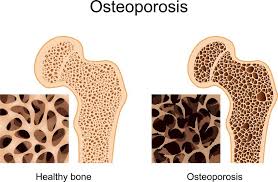Summary
Osteoporosis is a condition that affects the bones by weakening them. This weakening is related to the replacement of bone. Bones are living tissue. It is in a constant state of being broken down and replaced to keep bones strong. Osteoporosis occurs when the rate of creating new bone is much lower than the rate of old bone being lost.

Inside of a healthy bone is small spaces, similar to a sponge; this area of mesh is called trabecular bone. These spaces grow larger when you have osteoporosis. This in return makes the bone lose strength and density. When doing routine activities, such as standing and walking, people with osteoporosis are at high risk of fracturs, or breaks in bone.
Description
There are a few different types of causes of osteoporosis. One is family history. Because there are inherited factors that affect bone development, osteoporosis runs in families. So if a family member had or has osteoporosis, then you are more likely to also get it. Another cause is not receiving enough calcium or vitamin D. This is because calcium and vitamin D are important for both developing and strengthening bones. Lack of weight-bearing exercise will also make you more at risk of losing calcium from your bones and therefore develop osteoporosis. Another factor that partly affects rather or not you will get osteoporosis is how much bone mass you attained in your youth. The less amount of bone mass that you attained, the less amount of bone mass you have for when you are older and your production of bone is slowed down. Both heavy smoking and drinking can also cause osteoporosis. The body’s ability to make bone reduces from drinking a lot of alcohol.
Osteoporosis is not an uncommon condition. More than 53 million people either have it or at a high risk of it in the United States. It is more likely that you will get it as you grow older. This is because your body slows down the amount of new bone you create as you get older. Although anyone can get it, women are more likely to get it. Women are actually four times as likely to get it than men. This is because women during menopause have a reduction of their estrogen levels. This is one of the strongest risk factors for developing osteoporosis. People with small body frames also tend to have higher risk. This is because as they age, they have less bone mass to draw from. Another risk factor is people who get either too much or too little of certain hormones in their bodies. Some examples of this are lower sex hormone levels, too much thyroid hormone, or overactive parathyroid and adrenal glands.
Although most diseases will have a list of symptoms that can warn you if you have it, osteoporosis does not. In the early stages of bone loss, there are typically no symptoms. There are however some signs that may warn you that your bones are weakening.

An obvious sign is if your bones break much easier than expected. This shows that your bones are becoming weak. If you do have osteoporosis, the bones that are most likely to break are the wrists, ribs, hip or vertebra. Another big warning is if you have osteopenia. Osteopenia is the same as osteoporosis but less severe. If osteopenia continues to get worse, it might later change into osteoporosis. Your posture might also change as a sign. You will have more of a stooped, or curved, posture. Similarly to changing your posture, you might lose height over time if your bones are weakening.
Fortunately there are a few ways to both treat and prevent osteoporosis. The first way is by improving your diet. This includes adding more calcium and vitamin D to help strengthen your bones. By also doing regular weight-bearing exercises, you will help prevent weakening your bones. Although exercising is good for your bones, it is also important to avoid doing activities, such as twisting spine or bending forward from the waist, if you do have osteoporosis. Some of these activities include sit ups, toe touches, or swinging a gold club. Finally and most obvious solution is getting medication from your doctor. If suspected to have osteoporosis, your doctor might suggest you get a DEXA (dual energy x-ray absorptiometry) scan. This scan measures the density of your bones.
Articles
MED Shadow tells us about a women who did not want to take bisphosphonates when diagnosed with osteopenia, which can later turn into osteoporosis. This is because of a long list of medication side effects. It is then said that nutritional supplements and exercise help improve density in bones.
Juvenile Arthritis News informs us about how a medicine, called Risedronate, can help children and teens who take steroids to control their rheumatic disease. It helps reduce risk of bone fractures and bone loss. This medicine belongs in a class of compounds that is usually used for people with osteoporosis.
Web MD warns us about the drug Reclast. It is prescribed to postmenopausal women to treat or prevent osteoporosis. The FDA states that it raises the risk of kidney failure.
References
“Osteoporosis: Symptoms, Causes, Tests, and Treatment”; my.clevelandclinic.org; https://my.clevelandclinic.org/health/diseases/4443-osteoporosis
“Osteoporosis- Symptoms and Causes”; mayoclinic.org; https://www.mayoclinic.org/diseases-conditions/osteoporosis/symptoms-causes/syc-20351968
“What Do You Want to Know About Osteoporosis”; healthline.com; https://www.healthline.com/health/osteoporosis
“Osteoporosis”; National Institute on Aging; https://www.nia.nih.gov/health/osteoporosis